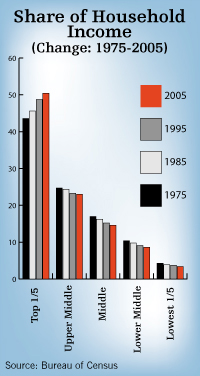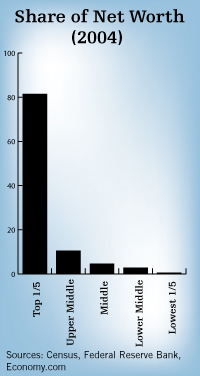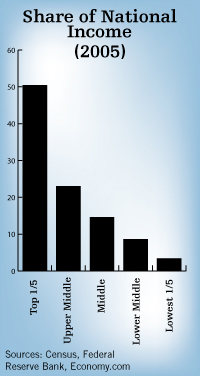Course:SSED317/Social Class
Home Page: SSED317
Group Members: Phoebe, Celina, Bobby, Dave, and Courtney
SSED 317: Social Class
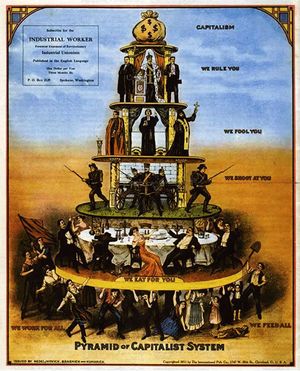
Background
Definition
The term 'social class' refers to the hierarchical distinctions (or stratifications) between individuals or groups in societies or cultures. Although not all societies possess a notion of social class, the concept is usually based on the following criteria: economic position (personal or household income/wealth), occupation, education or qualifications, family background, or political interests. As a social construct, social class can be ascribed (meaning from birth) or achieved (based on merit, skill, or ability) and often results in an adoption of particular lifestyles and stylistic traits and the accumulation of social prestige. Consequently, social class is often expressed by one's clothing, personal grooming, manners and refinement, as well as one's reputation within the larger social community. Although social class is generally perceived as a consequence of wealth, the adoption of stylistic traits (or 'cultural capital') can be as important as wealth in determining social class.
Generally speaking, social class is divided into three tiers or levels: the upper class, middle class and lower class. Commonly referred to as 'the bluebloods,' the upper class is generally possess (or are perceived to possess) great wealth as a consequence of inherited privilege. Members of the middle class, otherwise known as 'average Joes,' can be broken down into two main categories: the 'upper' middle class and the 'lower' middle class. The 'upper' middle class consists of highly educated, well-paid professionals with considerable work autonomy, while the 'lower' middle class is considered to be a class of college educated, loosely supervised semi-professionals and craftsmen. Occupying the bottom of the social hierarchy, the lower class is associated with low-level retail and service workers, as well as the frequently unemployed or those not able to work.
Complicating the concept of social class is the notion of intersectionality. Defined as a theory which seeks to examine the ways in which various socially or culturally constructed categories interact in society to create social inequality, intersectionality highlights how concepts such as race, ethnicity, religion, sexual orientation and gender contribute (both directly and indirectly) to one's social class within society. According to intersectionality theory, classical models of oppression within society, such as race/ethnicity, gender, relgion, nationality, etc. do not act independently of one another. Instead, more than one form of oppression interrealte creating a system of oppression that reflects the 'intersection' of multipple forms of discrimination.
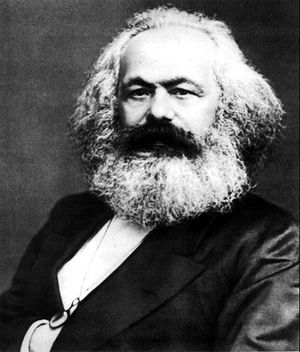
Although intersectionality is an important paradigm for sociological and cultural studies, many challenges exist in utlizing the theory to its fullest capacity since it is difficult to account for the ways in which all of the forms of oppression interact to create a social hierarchy. For example, a woman's position within society cannot be adequately defined as a function of her gender; instead, to understand/describe a woman's experience it is necesssary to examine her race, sexual orienation, class, religion, etc. The difficulty of implementing intersectionality arises when attempting to explore one's 'ultimate' or 'most defining' oppressive factor. [1] By: Celina Martin
Marxian Class Theory
Karl Marx became the first person to critically attack the privileges not just of an hereditary upper class, but of anyone whose labour output could not begin to cover their consumption of luxury. The majority proletariat which had previously been relegated to an unimportant compartment at the bottom of most hierarchies, or ignored completely, became Marx's focal point. He recognized the traditional European ruling class ("We rule you"), supported by the religious ("We fool you") and military ("We shoot at you") élites, but the French Revolution had already shown that these classes could be removed. Marx looked forward to a time when the new capitalist upper class could also be removed and everyone could work as they were able, and receive as they needed. Karl Marx defined class in terms of the extent to which an individual or social group has control over the means of production. In Marxist terms a class is a group of people defined by their relationship to the means of production. The prerequisite for classes is existence of sufficient surplus product. Marxists explain the history of "civilized" societies in terms of a war of classes between those who control production and those who produce the goods or services in society. In the Marxist view of capitalism, this is a conflict between capitalists (bourgeoisie) and wage-workers (the proletariat). For Marxists, class antagonism is rooted in the situation that control over social production necessarily entails control over the class which produces goods -- in capitalism this is the exploitation of workers by the bourgeoisie. Marx himself argued that it was the goal of the proletariat itself to displace the capitalist system with socialism, changing the social relationships underpinning the class system and then developing into a future communist society in which: "..the free development of each is the condition for the free development of all." (Communist Manifesto).
Critiquing Social Class in the B.C. Curriculum (1941-1997)
Creating the Curriculum
Generally speaking the Social Class curriculum is created by two parties in British Columbia: Teachers (union members) & Ministry Personnel. Both parties are generally influenced by dominant political ideologies. Consequentially, this political influence can be seen throughout the curriculum or the Integrated Resource Packages (IRP), which can be detrimental to students since they serve the interest of those deciding what gets into the documents. (http://ojs.library.ubc.ca/index.php/newproposals/article/view/118/130)
1941
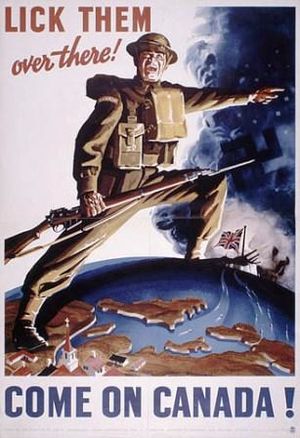
The first published version of the Social Studies curriculum was developed in 1941 during World War II. During this period, the majority of the Social Studies curriculum is based around the war itself, and nationalism. Nevertheless, the curriculum in 1941 fails to cover the atrocities on the war front (i.e. trench warfare), the working-class young men that fought in the war, and the rights of the worker. (http://ojs.library.ubc.ca/index.php/newproposals/article/view/118/130)
1949
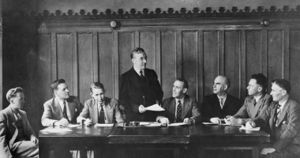
In 1949, the rights of the worker has completely disappeared. This is in large part due to the growing development of the Cold War and the negative attitude towards bolshevism and communism. For example, the curriculum fails to recognize the Canadian Commonwealth Federation (CCF), which was a socialist group based out of Saskatchewan. The CCF was one of the first political parties to establish awareness for publicly funded healthcare. This important debate between public vs. private healthcare was omitted from the curriculum due to the parties left-wing nature. (http://ojs.library.ubc.ca/index.php/newproposals/article/view/118/130)
1956
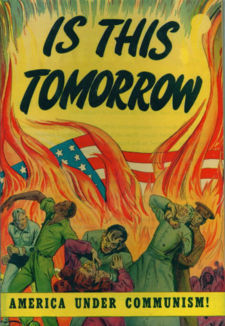
In 1956, the curriculum is written from a liberal and conservative perspective. Again, this re-emphasizes that the majority of the curriculum developers were anti-communist. Students were to believe that the economy was healthy and great throughout North America, when truthfully there was a conflict between labor and capital. (http://ojs.library.ubc.ca/index.php/newproposals/article/view/118/130)
1968
In 1968, curriculum developers completely removed trade unions and labour legislation from the curriculum. Only in Social Studies 9 is there any reference to the blue collar worker (Industrial Revolution). Furthermore, in the 1960s, North Americas first public healthcare system was developed by the CCF (now a socially democratic party). Given the parties socialist nature, there is no reference to this event. (http://ojs.library.ubc.ca/index.php/newproposals/article/view/118/130)
1980
The curriculum in 1980 focuses students around the idea of citizens as consumers producers and taxpayers. This can be seen in the Social Studies 9 Unit, People in Resources. Students are to recognize that ALL people and societies are faced with the same economic problem: conflict between unlimited wants and limited resources. By focusing around material needs, this is overemphasizing a major part of capitalism (i.e. transforming workers into consumers). (http://ojs.library.ubc.ca/index.php/newproposals/article/view/118/130)
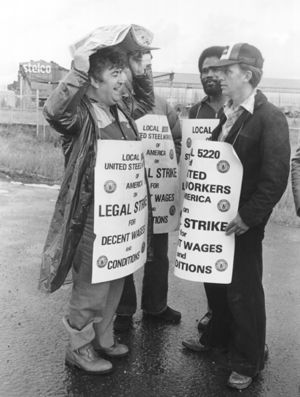
1988
During the 1980s, the curriculum continued to focus around worker organizations; however, only with regards to the Industrial Revolution (Going back to the 1968 Curriculum). The BC curriculum failed to recognize working organizations in the present, which is significant because capitalist and labour classes clashed throughout the 1980s. These clashes of the 80s were omitted throughout the curriculum. (http://ojs.library.ubc.ca/index.php/newproposals/article/view/118/130)
1997
In 1997, the curriculum expected that students would assess identity through family, gender, belief systems, ethnicity and nationality (1997: Prescribed Learning Outcome). Ironically, there is no mentioning of Social Class as assessing identity. The neglecting of Social Class can be seen throughout the curriculum, as our group only found less than a handful of readings relating to Social Class in Grade 8-12 text books. (http://ojs.library.ubc.ca/index.php/newproposals/article/view/118/130)
Statistics
Social Class Statistics from the United States:
Canadian Wealth Distribution (Canadian Center for Policy Alternatives)
population percentile and % share of national wealth
91-100 percentile = 53% of wealth
81-90 percentile = 17.4%
71-80 percentile = 11.2%
61-70 percentile = 7.7%
51-60 percentile = 5.1%
41-50 percentile = 3.3%
31-40 percentile = 1.8%
21-30 percentile = 0.7%
11-20 percentile = 0.2%
1-10 percentile = - 0.4%
In 1980, average CEO pay was 42 times greater than average blue-collar worker pay.
In 2006, average CEO pay was 364 times greater than average blue-collar worker pay.
In 1980, the top 1% earned 8% of national income. In 2004, the top 1% earned 16% of national income.
The top 20% earns 49.2% of the national income. The bottom 20% earns 3.6% of the national income.
The wealth of the top 1% of US households is greater than the wealth of the bottom 90%.
From 1984-2005, net worth doubled for the top 2%. From 1984-2005, net worth decreased for the bottom 25%.
From 2003-2005, people with a college education had a net worth increase of 31%. From 2003-2005, high school dropouts had a net worth decrease.
Between 52 and 81% of accumulated wealth is received through intergenerational transfers.
Sources
US Bureau of Statistics
www.aflcio.org/issues/jobseconomy/
www.sciencedaily.com/releases/2007/
www.npr.org/templates/story
http://sociology.ucsc.edu/whorulesamerica/power/wealth.html
Resources
Literature
Rags & Riches: Wealth Inequality in Canada. A report that analyzes data from Statistics Canada's Survey of Financial Security and previous surveys by the Federal Agency dating back to 1970. The focus of the surveys was accumulated wealth or net worth rather than current income. It tackles the questions: Who's rich? Who's poor? How has wealth changed over the years? (http://www.policyalternatives.ca/documents/National_Office_Pubs/rags_riches.pdf)
Who Rules in America? A presents details on the wealth and income distributions in the United States, and explains how we use these two distributions as power indicators.(http://sociology.ucsc.edu/whorulesamerica/power/wealth.html)
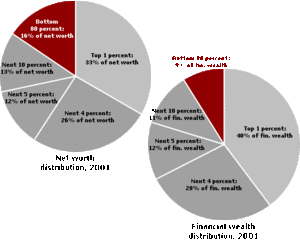
Social Class: The Forgotten Identity Marker in Social Studies Education. The paper describes a study that took place from 2002 to 2004 in which Paul Orlowski critically examined discourses pertaining to social class in two sources: the state-sanctioned social studies curriculum in BC high schools and interview transcripts with 10 social studies department heads in Vancouver BC that focus specifically on working-class issues in social studies.(Orlowski, Paul, "Social Class: The Forgotten Identity Marker in Social Studies Education." New Proposals: Journal of Marxism and Interdisciplinary Inquiry.Vol.1, No.2.Feb 2008: 29-47).
The Importance of Place: Facility Conditions and Learning Outcomes. The article focuses on the importance of conducive learning environments for successful learning. However, and unsurprisingly, not everyone has access to such environments due to the lack of funding. (Roberts, Lance, Jason D. Edgerton and Tracey Peter. "The Importance of Place: Facility Conditions and Learning Outcomes." Canadian Education Association. Vol.48, No.3. Summer 2008:48-51).
Working for a Living Wage: Making Paid Work Meet Basic Family Needs in Vancouver and Victoria. The Canadian Center for Policy Alternatives released a new study in September 2008 calling on major public and private sector employers to pay a living wage that would lift low-income families out of poverty and severe financial stress. The report argues that implementation of a living wage would allow lower-income families to avoid having to make impossible choices, such as whether to buy food or heat the house, feed the children or pay rent. The living wage calculation includes basic expenses for a two-earner family with two young children (such as housing, childcare, food and transportation), and government taxes, credits, deductions and subsidies. It finds that each parent would need to work full-time at an hourly wage of $16.74 in Metro Vancouver and $16.39 in Greater Victoria in order to pay for necessities, support the healthy development of their children and participate in the social and civil life of their communities. The full article can be downloaded from the Canadian Center for Policy Alternative website (http://www.policyalternatives.ca). By: Celina Martin
Educating in an Era of Orwellian Spin: Critical Media Literacy in the Classroom This article examines how different ideological perspectives are used to understand the relationship between corporate media and social, economic and political power systems. Of particular relevance to social class, pages 184-188 address social positionality and modern political ideologies. Orlowski, Paul "Educating in an Era of Orwellian Spin: Critical Media Literacy in the Classroom" Canadian Journal of Education 29, 1 (2006): pp. 176-198
Online Links
Statistics
Income Distribution Canada Census 2006 http://www12.statcan.ca/census-recensement/index-eng.cfm
Luxembourg Income Study. A cross-national data archive that includes information on income, the labor market, and demographics. It also has an application that visitors may download for information on country-level poverty and inequality indicators. (http://www.lisproject.org/)
SEDLAC. The Socio-Economic Database for Latin America and the Caribbeanwebsite includes statistics on poverty and other distributional and social variables in 21 Latin American and Caribbean countries. It allows users to monitor the trends in poverty and other distributional and social indicators in the region. (http://www.depeco.econo.unlp.edu.ar/cedlas/sedlac/)
TransMONEE. A database associated with the UNICEF Innocenti Research Centre’s MONEE project. The TransMONEE database captures a vast range of data relevant to the social and economic situation and well-being of children, young people and women in the countries of Central and Eastern Europe and the Commonwealth of Independent States (CEE/CIS).(http://www.unicef-irc.org/databases/transmonee/)

The Canadian Encyclopedia. The Canadian Encyclopedia, a branch of Histori.ca, offers a quick overview of the origins of social class from both Marxist and non-Marxist perspectives. The site provides a history of Marxist social class (ownership of the means of production and labour power), contemporary understandings of social class (as the product of occupation or levels of income), and offers a discussion of social class within a Canadian context (Canada as large and growing middle class of white-collar workers)(http://www.thecanadianencyclopedia.com). By: Celina Martin
Class Matters http://www.classmatters.org/
"Social Class in the USA" http://www.nytimes.com/pages/national/class/
Multimedia Resources
Social Class In America (1957). Sociological discussion of ascribed status, achieved status, vertical mobility and horizontal mobility in America. We follow the lives of three men from high school on through their professional lives. Rather pessimistic conclusion on the possibilities of movement across class boundaries. PART 1(http://www.youtube.com/watch?v=mHACox2UamQ). PART 2 (http://www.youtube.com/watch?v=uhI9V1fAHrY)
Income Inequality and the Middle Class (2007). Nobel Prize-winning economist and New York Times Op-Ed columnist Paul Krugman discusses the history of the American "middle class," and argues that growing income inequality may threaten its existence.(http://www.youtube.com/watch?v=5kwA-CwFK5A&feature=related)
Shaking the Tree (1995). What is social responsibility in education and is it necessary? Noam Chomsky keynotes this timely and provactive documentary which examines how various social issues are addressed, or not addresses, in public education. Broken down into the sections racism, First Nations, poverty, gender and sexism, gender and homophobia, violence prevention and the environment, 'Shaking the Tree' highlights how various social issues impact students, questions contemporary social justice policies, and questions the future of social justice in the public education system. University of British Columbia Library Call Number: LC192 .S425 1995 Video. By: Celina Martin
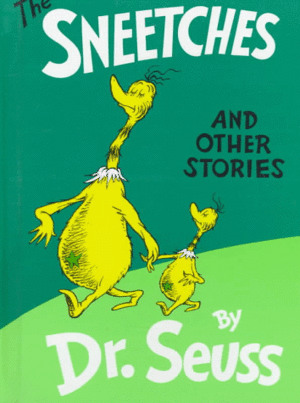
Sneetches. Dr. Seuss' classic book The Sneetches illustrates the concept of social stratification as a phenomenon that occurs whenever a group forms. Even within a small group comprised of 2-3 people, social stratification occurs as group members start ranking each other along a variety of dimensions such as intelligence, attractiveness, athletic ability, strength, wealth, etc. Such rankings permeate social life and affect one's opportunities. The Sneetches clip, in which "Sneetches are Sneetches" and "Star-Belly Sneetches are no better than Plain-Belly Sneetches," demonstrates how a social category without any inherent characteristic can become an unequalizing force once value is ascribed. In the case of social class, 'star's can represent 'poverty,' thus highlighting how the poverty label can affect one's perspective, opportunities and social status. [2] By: Celina Martin
Sample Lesson Plans
Cast In Stone? Examining the Caste System and Its Effects on Indian Society. In this lesson, students examine India’s caste system. After learning about the history and development of the caste system, students discuss a New York Times article about how new political power granted to women in lower castes is affecting the political and social climate of India. Students then work in small groups to explore the economic, social and political 'rules' of the different classes in the Indian caste system. (http://www.nytimes.com/learning/teachers/lessons/19990505wednesday.html?searchpv=learning_lessons)
Not Everyone Lived In Castles. Many people think of the Middle Ages as a romantic time when gallant knights rescued lovely damsels in distress and everyone lived in castles. But that's only one small facet of the picture. In this lesson, students will learn about the lifestyle of the wealthy elite and then expand their view of medieval society by exploring the lives of the peasants, craftsmen, and monks. (http://edsitement.neh.gov/view_lesson_plan.asp?id=448)
Who is Worthy of Knighhood? In this lesson, students are encouraged to examine the social role of knights within the late Middle ages. Given the social divisions characteristic of the late Middle Ages, students explore how a social hierarchy impacted one's opportunites, social class and self-perception since only nobility were eligible for knighthood. Upon establishing sufficient background knowledge through note-taking, think-pair-share, and group discussion, students engage in an individual assignment exploring the continuity and change characteristic of contemporary knighthood. By: Celina Martin
- Lesson Title: Knighthood and Chivalry
- Critical Question for the Lesson:
- Who was worthy of knighthood in the late Middle Ages (given the social divisions within medieval society)?
- Rationale:
- During this lesson, students will be encouraged to interact with various ‘resources’ aimed at demonstrating the hierarchy characteristic of the late Middle Ages. In doing so, students will be able to critically examine how the concept of social hierarchy determined the selection and ‘worthiness’ of knighthood and chivalry. Upon establishing a common understanding of knighthood and chivalry, students will engage in a class discussion aimed at establishing connections between the hierarchy of the late Middle Ages and the social divisions affecting today’s adolescence. By highlighting the connections between medieval and contemporary social hierarchies, students will develop both an understanding of historical continuity and change, as well as appreciate how social status can influence one’s life opportunities.
- Introduction (10 Minutes):
- Students will be instructed to discuss in small groups the rules, obligations, roles and attitudes characteristic of contemporary society. Following a short discussion, ask the students such questions as: “what attitudes are valued within our society,” “what are some of the obligations adolescents face today,” or “which positions within society are most desired?” Generating class discussion regarding contemporary issues of social hierarchy, values, and norms will lead into a brief overview of the lesson’s topic (knights and chivalry) as ‘not so different’ from adolescent’s lives today.
- Body of Lesson (25 Minutes):
- Guide students through note-taking on knighthood (on over-head projector).
- Instruct students to work in pairs (think-pair-share) to discuss the role of chivalry as central to knighthood, a distinction of social class, and a social value within medieval society. Ask students to discuss who was eligible to become a knight, what rules, obligations, roles and attitudes were deemed important to medieval knighthood, and the social position of medieval knights. How was knighthood in the late Middle Ages similar/different to contemporary knighthood?
- As a class, discuss the conclusions of the think-pair-share discussion. Pass out and explain the contemporary example of knighthood assignment.
- Closure (5 Minutes):
- To conclude the lesson, the teacher will redirect student’s attention to the front of the class to recap the key points of knighthood and chivalry: the education of a knight, the social position of knights within society, and a knight’s code of chivalry. Upon summarizing the lesson, students will be directed to consider the theme of social hierarchy in medieval society as a determinant of knighthood, as well as to consider how social hierarchies function in contemporary society. Ask students: Are there any people in society who have more opportunities than others? Can you think of any situations in which money or reputation gives people an advantage? Does money or social status increase your chances of being successful/anything you want to be? Lastly, ask students to consider the changing role of knighthood: How has knighthood changed from medieval to contemporary society? Encourage students to consider on their own time how social divisions in history may have changed but continue to play an influential role in society today.
- Assignment (25 Minutes):
- Students are instructed to complete a short research-based assignment on contemporary knighthood. Students will be instructed to research a recent example of knighthood (such as Sir Elton John, Sir Paul McCartney, etc) using the internet or other sources. In paragraph form, students will compare medieval and contemporary criteria for knighthood. The assignment will address such questions as:
- What does it mean to be a knight in the middle ages?
- How has the meaning of knighthood changed?
- What criteria does one have to meet to be eligible for knighthood today?
- Do you agree with the standards set for knighthood today?
Lesson Title: Oppression of the Working Class
Critical Question: During the late 19th and early 20th centuries, how did social conditions and labour laws affect working-class people?
Rationale: This lesson will address the social and political aspects of the latter stages of the Industrial Revolution in Britain and the United States. Students will examine poor laws and workhouses, <http://www.workhouses.org.uk/ > labour legislation and images of factory workers. An emphasis will be placed on child labour. Photos of 21st century child labour in less developed countries will be used to conclude the lesson. The lesson will help students understand the challenges faced by the working class and the difficulties associated with changing the status quo.
Introduction: Late 19th century images of working children will be used to introduce students to factory conditions. Students’ reactions and thoughts will be discussed.
Body: Students will learn about Victorian poor laws and workhouses. The effects of these policies on the working class will be discussed. Students will also learn of the American working class experience. Photos of child labourers will be examined. Students will be asked to consider the social implications of these working conditions and policies.
Multiple Ability Task: Working in groups of four, students will be asked to create an advertising poster. The poster will promote improving conditions for the working class, especially children. Posters will be expected to propose new legislation and include facts, slogans and images that support social reform.
Conclusion: Contemporary photos of child labourers will be shown and discussed, along with the need for further social reform, both locally and globally. The discussion will conclude with an exchange of ideas for individual activism.
Sample Activities

Chess: A Game or Rules For Society? This particular lesson is a one day activity that can be used almost any time during a Western European History Unit.At the conclusion of the lesson, each student will be able to identify the social classes of medieval Europe, and utilize the chess board and pieces to understand their relationship to each other.(http://www.col-ed.org/cur/sst/sst174.txt)
Multiple Ability Tasks
Music as a Content Carrier: In this Multiple Ability Task, students will be divided into groups of four or five and asked to create a song based on their knowledge of social class structure and division in the Middle Ages. This lesson will take place at the end of the unit so that the students will already have some experience with the subject and further resources will be available as well (texts, photographs, primary documents, etc.) This will involve cooperative learning as all students are required to participate in the writing and performance process.
Part 1:
Each group will brainstorm ideas on the Middle Ages and write down as many points, concepts and key terms as they can from the information provided in previous classes as well as from the text and other primary and secondary documents (photographs). By circling the group, each individual student will contribute to the brainstorm session by suggesting ideas.
Part 2:
The group will then decide on a popular and appropriate song to use. This can include anything from a popular folk song to a more current song.
Part 3:
The group will then create lyrics to their song using the key ideas and concepts that they brainstormed in part 1. Going around the circle again, students will each get an opportunity to suggest a line or two for the song.
Part 4:
Groups will perform their song either to other groups or the entire class.
At the end of the class students will be asked, "how do you see different social classes within our society today?" This is an individual assignment and the method of presentation will be up to each student. They will all have until the next class to answer this question in whichever fomat they decide; a write-up, drawing, oral presentation, song, play, etc. This will encourage students to express their knowledge to the teacher or class however they feel most comfortable.
Teaching Social Class using Multiple Intelligence
A UK Website (http://www.rspnorthants.org.uk/materials/music.html)
Bibliography
Jacobs, G.M.,Power, M.A., and Inn, L.W. (2002). The Teacher's Sourcebook for Cooperative Learning. California: Corwin Press.
Chapter 6: Principle:Equal Participation, looks at the use of cooperative learning in the classroom. The authors define multiple ability tasks and give several suggestions on ways to incorporate their use in the classroom and how to combine them with cooperative learning.
Knudsen, Susanne V. (2006). Intersectionality: A Theoretical Inspiration in the Analysis of Minority Cultures and Identities in Textbooks. Caught in the Web or Lost in the Textbook. 61-76.
- Knudsen's article looks at the theory of intersectionality as more than "gender research , more than studying differences between men and women, and more than diversities within women's groups or men's groups." Instead, Knudsen asserts that intersectionality tries to "catch the relationships between socio-cultural categories and identities." Through a discussion of additive and transversal intersectionality, in combination with Michel Foucault's notion of power, Knudsen concludes that intersectionality has the aim of increasing democracy and equality with resorting to 'mainstream' or 'normalizing' methods. In textbook research, Knudsen argues that intersectionality may be used to deconstruct normalization, homogenization and classification, since intersectionality "may make us aware of the complexity, and the ways textbooks reduce, exclude and include categories and identities (such as curriculum subject or interdisciplinary, pupilness, nationality, ethnicity, gender, sexuality, dis/ability and class." By: Celina Martin
Malott, C., & Pruyn, M. (2006). Marxismhttp://wiki.ubc.ca/Social_Class and Critical Multicultural Social Studies. In E. W. Ross (Ed.), The social studies curriculum (3rd Ed., pp., 157-170). Albany: State University of New York Press.
Anyon, J. (1981). Social class and school knowledge. Curriculum Inquiry, 11(1), 3-41.
Class Readings
From Text
Malott, C., & Pruyn, M. (2006). Marxismhttp://wiki.ubc.ca/Social_Class and Critical Multicultural Social Studies. In E. W. Ross (Ed.), The social studies curriculum (3rd Ed., pp., 157-170). Albany: State University of New York Press.
Download
Anyon, J. (1981). Social class and school knowledge. Curriculum Inquiry, 11(1), 3-41.
